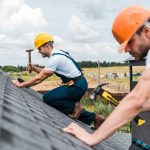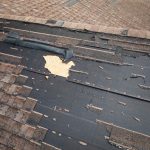
Wisconsin winters are beautiful, we get about 48 inches of snow a year. But that snow brings ice dams – thick ridges of ice that form along the edges of your roof and trap melting snow causing water damage. Ice dams can wreak havoc on your home, from roof leaks and shingle damage to gutter failures and structural issues. As seasoned roofers with over 6 decades of experience, we know preventing ice dams is key not only to avoiding costly repairs but to protecting your home itself.
Ice dams are particularly problematic in cold climates, where snow on the roof melts and refreezes at the edges, creating a barrier that prevents proper drainage. This trapped water can seep under shingles, damaging the roof structure and even leading to interior leaks.
proper insulation and ventilation are key to preventing these ice formations and protecting your home from winter’s harsh effects.
In this guide, we’ll explore some best tips to prevent ice dams from forming on your roof, ensuring your home stays safe and dry throughout the winter season.
Understanding Ice Dams
Ice dams are ridges of ice that form at the edge of a roof, causing significant damage by preventing proper drainage and leading to water intrusion into the home.
When water from melting roof snow runs down and refreezes at the colder edges and gutters, it creates a block that prevents proper drainage.
This cycle of melting and refreezing, known as ice dam forming, leads to the buildup of roof ice dams, which can eventually cause water to pool and leak into the home as roof melts occur.
Ice dams primarily form when:
- The attic temperature rises above freezing
- This causes snow on the roof to melt and refreeze at the eaves and gutters
- When warm air melts only a portion of the ice on the roof, it exacerbates both ice dam formation, creating a cycle of melting and freezing that is difficult to break.
The damage caused by ice dams can be extensive. Backed-up water can leak into the home, affecting walls, ceilings, and insulation. The refreezing water can lift roof shingles, allowing even more water to enter the home. Understanding these mechanisms is essential for preventing ice dams and protecting your home from potential damage.
As winter approaches, it’s vital to recognize the signs and causes of ice dams. Recognizing the conditions that lead to ice dam formation and taking proactive steps can save you from the headaches and expenses of ice dam damage.
Causes of Ice Dam Formation
Ice dams form due to a variety of factors. Insufficient attic insulation is a major contributing factor. Inadequate insulation allows heat to escape into the attic from the living spaces, warming the roof and melting the snow. This melted snow then refreezes at the colder edges, forming ice dams.
Inadequate ventilation also plays a significant role. Good airflow from eaves through roof vents is essential to keep attic air cold and reduce the risk of ice dams. Without proper ventilation, warm air from the attic can increase the roof temperature, leading to melting snow and subsequent ice dam formation. Ensuring proper circulation of cold air can help prevent these issues.
Finally, there are several causes of ice dams that you should address to prevent them and protect your home:
- Inadequate insulation in the attic
- Inadequate ventilation in the attic
- Warm air leaks from the living spaces into the attic, which can occur around vents, chimneys, and other openings
By addressing these causes, you can prevent ice dams and protect your home.
Signs You Have an Ice Dam Problem
Recognizing the signs of an ice dam problem early can save you from extensive damage. One of the most visible signs is the presence of icicles at the roof edge or gutters.
These icicles indicate that water is not properly draining from the roof, which could be due to ice dams.
Interior water damage is another clear sign. If you notice water stains or leaks on your ceilings or walls, it could be due to ice dams preventing proper drainage and causing water to seep into your home.
Additionally, ice forming on exterior walls, beneath siding, or behind the soffit can indicate an ongoing ice damming issue.
Effective Strategies to Prevent Ice Dams
Preventing ice dams involves a multi-faceted approach. Key strategies include improving
- Attic insulation
- Sealing air leaks
- Enhancing roof ventilation
Each of these strategies addresses a different aspect of the ice dam formation process, helping to maintain a consistent roof temperature and prevent ice buildup.
Improve Attic Insulation
Maintaining a uniform roof temperature to help prevent ice dams requires proper attic insulation. Insulation prevents heat loss from the living spaces into the attic, reducing the amount of snow that melts on the roof.
The recommended R-value for attic insulation is at least R-30, with R-40 being preferable in colder climates.
Adding insulation with a high R-value per inch can significantly cut down on heat loss by conduction. The depth of fiberglass or cellulose insulation should be 12 to 14 inches to meet building codes and effectively prevent ice dams.
Properly installed insulation, especially where the roof meets the wall, is critical to preventing ice dams.
Apart from insulation, effective air sealing is also important. Sealing air leaks and ensuring that the attic floor is properly insulated can prevent warmth from escaping into the attic and causing ice dam issues.
This combination of insulation and air sealing can significantly reduce the risk of ice dams forming on your roof.
Seal Air Leaks
Another preventive measure for ice dams is sealing air leaks in the attic floor and around vents. Common areas where leaks occur include:
- around wires
- plumbing vents
- light fixtures
- chimneys
Ensuring that these areas are properly sealed can prevent warm air from escaping into the attic and contributing to ice dam formation.
In some cases, kitchen or bathroom exhaust systems that terminate just above the roof may need to be moved or extended to reduce snow melting.
By addressing these air leaks, you can maintain a more consistent temperature in the attic and reduce the risk of ice dams.
Enhance Roof Ventilation
Maintaining consistent roof temperature and preventing ice dams necessitates proper attic ventilation. Good airflow from under the eaves or soffit area along the underside of the roof and out through roof vents helps keep the attic air cold and reduces the freeze/thaw cycle.
The minimum ventilation area should be about one square foot of vent per 300 square feet of ceiling area.
Keeping soffit vents clean and unobstructed aids in proper attic ventilation, reducing ice dam risks. Natural roof ventilation helps maintain uniform roof temperatures, further reducing the risk of ice dams. Ensuring that your attic ventilation system is working correctly is a key step in preventing ice dams.
Using Ice Dam Prevention Products
Various products are designed to prevent ice dams, including:
- Heated cables, also known as high-resistance wires, which are mounted on the roof edge to melt ice dams and create drainage channels for melting water
- Ice melt socks, which are filled with ice melt and placed on the roof to melt ice dams
- Gutter guards, which prevent debris from clogging the gutters and causing ice dams
These products help prevent ice dams from forming and ensure proper water flow.
Ice melt socks can also be effective. These are made by filling a pantyhose leg with calcium chloride ice melter and placing it across the ice dam.
This creates a channel for water to flow down into the gutters. Additionally, mesh gutter guards keep debris out while allowing water to flow, reducing the risk of ice buildup in gutters.
Regular Maintenance Tips to Prevent Ice Dams
Preventing ice dams demands regular maintenance. This includes practices such as roof raking after snowfall and cleaning gutters to ensure proper water drainage.
These simple steps can significantly reduce the risk of ice dams forming on your roof.
Roof Raking After Snowfall
Removing excess snow after heavy snowfall using a roof rake is a reliable prevention method for ice dams.
Roof rakes, which are long-handled devices, allow you to pull snow off the roof while standing on the ground. This helps reduce the exterior temperature of the roof without damaging the shingles.
Specialized roof rakes, like the MinnSnowta Roof Razor®, can make snow removal easier and safer for homes with high roofs. Some benefits of using a specialized roof rake include:
- Easier and safer snow removal
- Preventing ice dams by raking snow off the first few feet of the roof’s eaves
- Reducing the risk of roof failure by preventing heavy snow loads
Regular snow removal with a specialized roof rake can help protect your roof and ensure its longevity.
Cleaning Gutters
Clear gutters and downspouts of debris and snow are key in preventing ice dams. Regular inspection and cleaning of downspouts ensure that water can flow away from the roof efficiently.
Clear gutters and downspouts of snow and icicles throughout the winter to prevent ice dams.
By maintaining clear gutters, you ensure proper water drainage, reducing the likelihood of ice dams forming. This simple maintenance task can save you from significant roof damage and water intrusion.
What To Do If You Already Have Ice Dams
If ice dams are already present, using a steamer for ice dam removal is recommended. This method melts the ice without damaging the roofing materials.
De-icing techniques can prevent further damage to the roof by removing the dams that have already formed.
Hiring a professional roofing company to address the issue is another safe and effective option. Professionals know exactly how to take care of the ice forming on your roof with the least amount of risk of damage to your home.
Avoid hacking away at ice dams with tools like hammers or shovels, as this can be dangerous and damage the roof.
Dealing with ice dams? Contact Prairie Exteriors for safe and effective removal services to prevent further damage.
Long-Term Solutions for Ice Dam Prevention
Addressing the root causes is essential for long-term ice dam prevention.
This involves enhancing
- ventilation
- bolstering insulation
- sealing air leaks.
A holistic approach helps maintain a consistent roof temperature, thus preventing ice dam formation.
Weatherization contractors can perform a blower door test to assess the airtightness of a ceiling, helping identify areas of excessive heat loss.
By addressing these areas, you can significantly reduce the risk of ice dams and protect your home in the long term.
Invest in long-term solutions for ice dam prevention. Call Prairie Exteriors today to create a tailored plan for your home’s protection.
Why Choose Prairie Exteriors & Painting for Your Roofing Needs
Prairie Exteriors & Painting has decades of experience in handling roofing projects, assuring expertise and reliability.
Operating in the Greater Madison area and servicing Dane and Sauk counties, they are equipped to meet all your exterior home improvement needs.
We partner with top brands like:
- LP Smartside
- Rollex aluminum
- Leafmaster Pro gutters
- Owens Corning
- Decra XD Shingles
- ProVia windows
- Deckorators & TimberTech decks
- Sherwin-Williams paints
With a project portfolio available for viewing and free quotes for both home and commercial roofing projects, Prairie Exteriors & Painting is your trusted partner for all roofing needs.
Preventing ice dams is a smart way of protecting your home from winter damage. By understanding the causes, recognizing the signs, and implementing effective strategies like improving insulation, sealing air leaks, and enhancing ventilation, you can keep your roof last long with these safety measures.
Trust Prairie Exteriors with your roofing needs. Contact us for a free quote and see why we’re Madison’s top choice for exterior home improvements.








